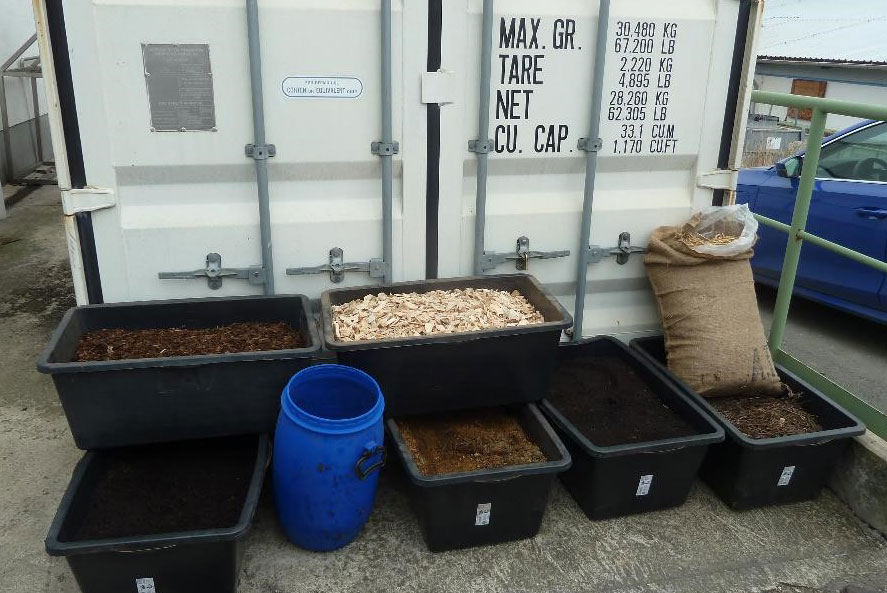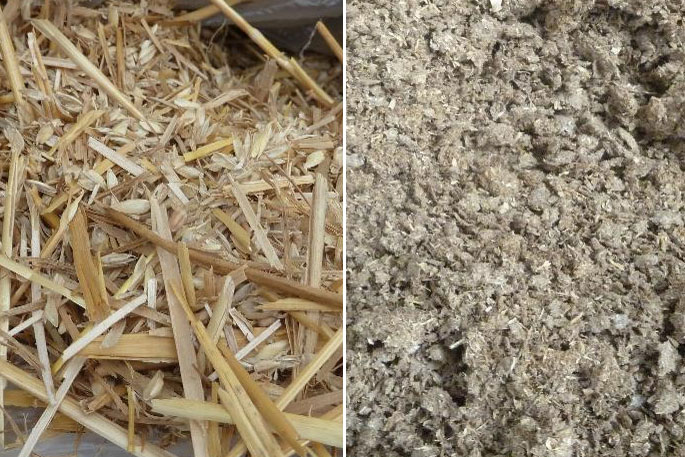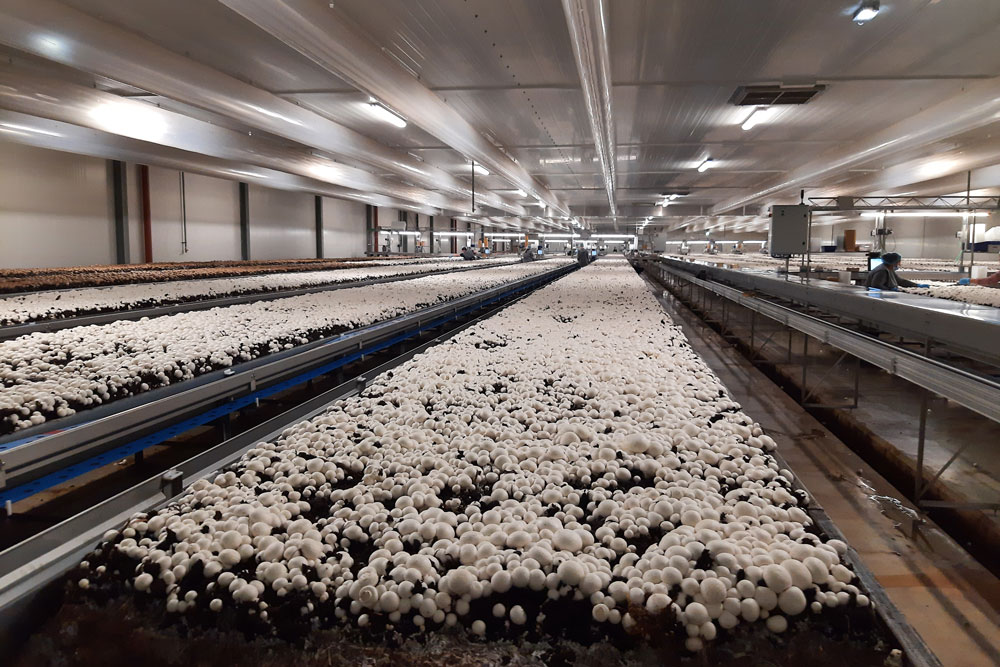Authors: Annika Ballin, Nico Domurath, Marc Lincke
Peat-free casing soils for sustainable mushroom cultivation
Using biomass technologies and nutrient recycling, IKTS researchers are working with partners to develop environmentally friendly and high-yield peat alternatives for edible mushroom cultivation. The focus is on the efficient use of regional renewable raw materials and biogenic residues.
Champignons, oyster mushrooms, shiitakes and other mushrooms are becoming increasingly common on our plates. And mushrooms are also gaining in importance worldwide for medicine and cosmetics. In parallel to the high demand, domestic mushroom production has been growing for years, and with it the need for growing media and casing soils. Cultivated mushrooms, such as champignons, grow on compost and horse manure substrates covered with a layer of peaty soil. Every year, approx. 340,000 t of substrates and 55,000 t of peaty casing soils are required for this purpose throughout Germany.
Mushroom cultivation must become peat-free by 2030
However, peat extraction destroys important natural CO2 reservoirs, the peatlands, and with them the habitat of many plants and animals. In its "Climate Protection Program 2030", the German government has therefore stipulated that commercial horticulture, which includes mushroom cultivation, must become peat-free by 2030.
This poses major challenges for the entire agricultural industry and, with it, for mushroom growers. This is because high-yield peat alternatives are hardly available so far. Coconut fibers, green compost, paper or the reuse of already used peat-containing products, such as casing soils, have not yet brought mushroom growers the desired success. In addition, peat alternatives are not regionally available or are often expensive from native raw materials. Little research has been done to date on the optimal casing soil for different fungal cultures. The formulations of peat-based soils available on the market vary depending on the manufacturer. In addition, there is a lack of native, species-specific casing soils, i.e. for each fungus its specific substrate.
Casing soils used in mushroom cultivation usually end up in composting plants or as fertilizer in the field after harvest. Before they leave the farm, they have to be thermally hygienized. This is cost- and energy-intensive. At this point, they usually still contain up to 30 % of valuable ingredients: an interesting source of nutrients.
Exotics in the ceramics institute
At first glance, the "Biomass Conversion and Nutrient Recycling" working group of the Fraunhofer Institute for Ceramic Technologies and Systems IKTS is an exotic presence in the ceramics institute. But biomass technologies have been researched at IKTS for decades. The team of group manager Marc Lincke and agricultural expert Nico Domurath deals with complex technical processes to optimally break down biomass for energy or material use. The focus is always on efficient and sustainable recycling technologies. Ceramic components, such as membranes, are often, but not always, used here.
"MykoDeck" aims to advance peat-free mushroom cultivation
In the MykoDeck project, the IKTS team has been working together with researchers from the Institut für Holztechnologie Dresden gGmbH (IHD) and compost specialists from LAV Technische Dienste GmbH & Co. KG since August 2021 on novel, peat-free casing soils for the production of cultivated mushrooms. For this purpose, different raw materials are to be evaluated and new formulations and manufacturing processes developed and tested under real conditions in mushroom farms. The consortium is initially concentrating on the needs of champignons. However, the results should be transferable to other cultivated mushroom species and to horticulture.
A key aspect of the project is the efficient development and use of regionally produced biogenic residues (e.g. green cuttings, hardwood residues, shives, removed mushroom substrates) and renewable resources as a peat substitute. This closed-loop approach is intended to recycle nutrients, conserve resources, and save greenhouse gas emissions that were previously generated during peat extraction and transport.
What do champignons need? And what do biogenic residues and renewable resources offer?
The project started with the definition of the most important requirements for champignon casing soils. Against this background, the biomass experts of Fraunhofer IKTS and its partners, analyzed and compared the chemical, biological, and physical properties of different peat-based casing soils as well as a number of imported (coco peat, rice/corn straw, pine bark) and native peat substitutes (composts, wood chips, straw, etc.). The data collected included nutrient content, pH, water holding capacity, gas exchange, particle and pore size distribution, and storage densities.
Biomass preparation and first growth trials
In the next step, mixtures with defined contents of mineral components and organic nutrients will be produced from the investigated starting materials in order to adjust the desired properties of the peat substitutes. Initial preliminary tests at the IHD have already shown that the champignons grow in the peat-free casing soils developed. Starting in the fall of 2022, the team plans to conduct larger-scale growth trials under real-world conditions to evaluate yields and pest pressure of the champignons on each peat alternative and formulation.
In parallel, the IKTS researchers are developing technologies to ensure consistently high product qualities compared to peat-based casing soils. These include, on the one hand, methods and processes for biomass conversion with which the nutrients contained in the biomass can be better broken down or the physical properties of the raw materials can be improved. On the other hand, these are technologies for the hygienization of biomass. For example, thermal processes are used to kill pathogens. So far, a combination of pulping, homogenization and composting has shown particularly good results.
LAV Technische Dienste GmbH & Co. KG is testing various composting processes for the production of aggregates or peat substitutes for casing soils as part of the project. Based on the results, the Institut für Holztechnologie Dresden gGmbH will develop various formulations for peat-free casing soils using these aggregates and peat substitutes. The yields are to be further increased by adapting the casing soils to the requirements of different fungal species and strains.
In practical testing with mushroom growers
The new formulations and manufacturing processes for the peat substitutes and casing soils are to be scaled up to technical scale from 2023 and tested under real conditions at several mushroom farms. The original two mushroom growers have now become five farms that want to participate in the MykoDeck research project. There is great interest in peat-free casing soils in the industry. This was also evident at the presentation of the project at the annual conference of the German Mushroom and Cultivated Mushroom Growers Association (BDC) e. V. (German) in Berlin on October 1, 2021. The findings of the practical tests will be used to develop concrete recommendations for the production and use of peat-free casing soils.
Economic viability and market potential
The tests are supplemented by ecological analyses and a profitability analysis. In addition to raw material availability and production costs, this will also look at possible target groups, a price and logistics strategy, and quality assurance measures. The aim of this ambitious project is to achieve ecologically sustainable and economical mushroom production that can completely dispense with the environmentally critical raw material peat. If the partners succeed in developing high-yield peat alternatives for mushroom cultivation, they are already thinking about transferring the technologies to the entire crop production sector.
The project (FKZ 2220MT005) is initially scheduled to run until July 2024. It is funded by the German Federal Ministry of Food and Agriculture (BMEL) via the Agency of Renewable Resources (FNR).
Further information
Stay informed: You are welcome to subscribe to our newsletter, read our other blog articles and follow us on LinkedIn, Instagram and YouTube.


